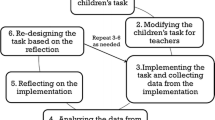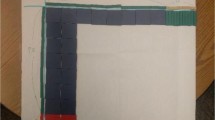Abstract
Existing studies have quantitatively evidenced the relatedness between problem posing and problem solving, as well as the magnitude of this relationship. However, the nature and features of this relationship need further qualitative exploration. This paper focuses on exploring the interactions, i.e., mutual effects and supports, between problem posing and problem solving. More specifically, this paper analyzes the forms of interactions that happened between these two activities, the ways that those interactions supported prospective primary teachers’ conceptual understanding, and the difficulties that prospective teachers encountered while engaged in alternating problem-posing and problem-solving activities. The results indicate that problem posing contributes to problem-solving effectiveness while problem solving supports participants in posing more reasonable problems. Finally, multiple difficulties that demonstrate prospective primary teachers’ misunderstanding with fractions and their operations provide insight for teacher educators to design problem-posing tasks involving fractions.



Similar content being viewed by others
References
Ball, D. L. (1990). Prospective elementary and secondary teachers’ understanding of division. Journal for Research in Mathematics Education, 21(2), 132–144.
Brown, S. I., & Walter, M. I. (1983). The “What-if-not” strategy in action. In S. I. Brown & M. I. Water (Eds.), The art of problem posing (pp. 65–105). Philadelphia: Franklin Institute Press.
Cai, J., & Hwang, S. (2002). Generalized and generative thinking in US and Chinese students’ mathematical problem solving and problem posing. The Journal of Mathematical Behavior, 21(4), 401–421.
Cai, J., Moyer, J. C., Wang, N., Hwang, S., Nie, B., & Garber, T. (2013). Mathematical problem posing as a measure of curricular effect on students’ learning. Educational Studies in Mathematics, 83, 57–69.
Chapman, O. (2012). Prospective elementary school teachers’ ways of making sense of mathematical problem posing. PNA, 6(4), 135–146.
Chen, L., Van Dooren, W., Chen, Q., & Verschaffel, L. (2011). An investigation on Chinese teachers’ realistic problem posing and problem solving ability and beliefs. International Journal of Science and Mathematics Education, 9(4), 919–948.
Contreras, J. (2007). Unraveling the mystery of the origin of mathematical problems: Using a problem-posing framework with prospective mathematics teachers. The Mathematics Educator, 17(2), 15–23.
Crespo, S. (2003). Learning to pose mathematical problems: Exploring changes in preservice teachers’ practices. Educational Studies in Mathematics, 52(3), 243–270.
Einstein, A., & Infeld, L. (1938). The evolution of physics. New York: Simon & Schuster.
Ellerton, N. F. (1986). Children’s made-up mathematics problems - A new perspective on talented mathematicians. Educational Studies in Mathematics, 17, 261–271.
Ellerton, N. F. (2013). Engaging pre-service middle-school teacher-education students in mathematical problem posing: Development of an active learning framework. Educational Studies in Mathematics, 83, 87–101.
Hruschka, D. J., Schwartz, D., St. John, D. C., Picone-Decaro, E., Jenkins, R. A., & Carey, J. W. (2004). Reliability in coding open-ended data: Lessons learned from HIV behavioral research. Field methods, 16(3), 307–331.
Kilpatrick, J. (1987). Problem formulating: Where do good problems come from?. In A. H. Schoenfeld (Ed.), Cognitive science and mathematics education (pp. 123-147). Hillsdale, NJ: Lawrence Erlbaum Associates.
Lamon, S. J. (1996). The development of unitizing: Its role in children’s partitioning strategies. Journal for Research in Mathematics Education, 27(2), 170–193.
Lavy, I., & Bershadsky, I. (2003). Problem posing via "What if not?" strategy in solid geometry: A case study. Journal of Mathematical Behavior, 22(4), 369–387.
Leung, S. S. (2013). Teachers implementing mathematical problem posing in the classroom: Challenges and strategies. Educational Studies in Mathematics, 83, 103–116.
Leung, S. S., & Silver, E. A. (1997). The role of task format, mathematics knowledge, and creative thinking on the arithmetic problem posing of prospective elementary school teachers. Mathematics Education Research Journal, 9(1), 5–24.
Ma, L. (1999). Knowing and teaching elementary mathematics: Teachers’ understanding of fundamental mathematics in China and the United States. Mahwah: Lawrence Erlbaum Associates.
Rosli, R., Goldsby, D., & Capraro, M. M. (2013). Assessing students' mathematical problem-solving and problem-posing skills. Asian social science, 9(16), 54.
Silver, E. A. (1994). On mathematical problem posing. For the Learning of Mathematics, 14(1), 19–28.
Silver, E. A. (1997). Fostering creativity through instruction rich in mathematical problem solving and problem posing. Zdm, 29(3), 75–80.
Silver, E. A. (2013). Problem-posing research in mathematics education: Looking back, looking around, and looking ahead. Educational Studies in Mathematics, 83, 157–162.
Silver, E. A., & Cai, J. (1996). An analysis of arithmetic problem posing by middle school students. Journal for Research in Mathematics Education, 27, 521–593.
Silver, E. A., & Cai, J. (2005). Assessing students’ mathematical problem Posing. Teaching children mathematics, 12(3), 129.
Silver, E. A., Mamona-Downs, J., Leung, S. S., & Kenney, P. A. (1996). Posing mathematical problems: An exploratory study. Journal for Research in Mathematics Education, 27(3), 293–309.
Singer, F. M., Ellerton, N., & Cai, J. (2013). Problem-posing research in mathematics education: New questions and directions. Educational Studies in Mathematics, 83, 1–7.
Stoyanova, E. (2000). Empowering students’ problem solving via problem posing: The art of framing “good” questions. Australian Mathematics Teacher, 56(1), 33–37.
Toluk-Uçar, Z. (2009). Developing pre-service teachers understanding of fractions through problem posing. Teaching and Teacher Education, 25(1), 166–175.
Author information
Authors and Affiliations
Corresponding author
Appendix
Appendix
-
Task 0

-
Task 1
A task from class:
In an adult condominium complex, 2/3 of the men are married to 3/5 of the women. What part of the residents is married?
-
1.
Solve this problem.
-
2.
Pose as many mathematics problems as you can in terms of fractions.
-
3.
Pose problems using either constraint manipulation strategy or goal manipulation strategy according to the problem you have solved, or you have posed, or any other ideas you have.
-
4.
Describe a plan that you have for solving one of the problems that you just posed.
-
Task 2
A situation from homework:
Adam put 1/2 of a cake in the freezer. Of the remaining half of the cake, Adam ate 1/5 and his dog ate the rest.
-
1.
Pose problems using either constraint manipulation strategy or goal manipulation strategy, or any other ideas you have.
-
2.
Solve one of the problems you have posed.
-
3.
Could you pose any other problems after solving the problem? List your new problems.
-
Task 3
A task from class work:
Q12. For each of the following, model the operation with your strip of paper, illustrate with a diagram the process you used, and shade your answer.
a. \( 3\times \frac{1}{4} \) b. \( \frac{1}{4}\times 3 \) c. \( \frac{1}{3}\times \frac{1}{4} \) d. \( \frac{1}{4}\times \frac{1}{3} \)
-
1.
Choose one of the operations and write a story problem representing it.
-
2.
According to the story problem you wrote in problem #1, use either the constraint manipulation strategy or goal manipulation strategy to write new story problems for each of the following:
a. \( \frac{3}{4}-\frac{1}{2} \) b. \( \frac{1}{4}+\frac{1}{3} \) c. \( \frac{2}{3}\div \frac{1}{2} \)
-
3.
Select the hardest problem you posed and solve it.
-
Task 4
A real-life situation:
Four people share a house with four separate rooms in a city that experiences cold winters. They usually split the electric charge (including gas costs) equally. For a very cold month (30 days), they got a bill of $243.95. However, one of them left for home for 18 days, which means she only lived in the house for 12 days. How could they split the bill for this case in a way that seems reasonable?
-
1.
Try to pose several easier mathematical problems based on the given situation using the constraint manipulation strategy or goal manipulation strategy.
-
2.
Solve the initial problem. If you could not solve this problem, try to come up with a plan or some ideas you have.
-
3.
Try to pose a more complex problem than the initial one.
Rights and permissions
About this article
Cite this article
Xie, J., Masingila, J.O. Examining Interactions between Problem Posing and Problem Solving with Prospective Primary Teachers: A Case of Using Fractions. Educ Stud Math 96, 101–118 (2017). https://doi.org/10.1007/s10649-017-9760-9
Published:
Issue Date:
DOI: https://doi.org/10.1007/s10649-017-9760-9





